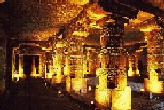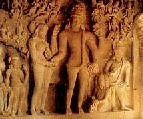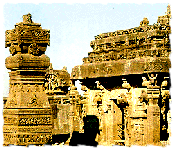|
Sites Near Pune

At about 400
kms northeast of Mumbai near to the city of Aurangabad, is located one
of the most beautiful Buddhist caves of Ajanta. Carvings depicting the
life of Buddha fill these breathtaking caves, which originally, date
back to around 200 BC. It was only in the 19th century, that the Ajanta
group of caves, lying deep within the Sahyadri hills, cut into the
curved mountain side, above the Waghora river, were discovered. A group
of British officers on a tiger hunt, stumbled on these ancient works of
art.
The beauty of the caves
The 29 caves were built as secluded retreats of the Buddhist monks, who
taught and performed rituals in the Chaityas and Viharas, the ancient
seats of learning, and nerve - centres of the Buddhist cultural
movement. Using simple tools like hammer and chisel, the monks carved
out the impressive figures adorning the walls of these structures.
Exquisite wall - paintings and sculptures speak volumes of the India of
yore. Many of the caves house panels depicting stories from the Jatakas,
a rich mine of tales of the several incarnations of the Buddha. Images
of nymphs and princesses amongst others are also elaborately portrayed.
It was the foresight of Buddha himself that the ink would perish but not
the rocks. Cave 1 houses some of the best - preserved wall paintings,
which include two great Boddhisattvas, Padmapani and Avalokiteshvara.
Caves 2, 16 and 17 also contain amazing paintings, while Caves 1, 4, 17,
19, 24 and 26 boast of some of the most divine sculptures. The flying
apsara, of Cave 17, and the image of Buddha preaching in Cave 17, are a
couple of unforgettable works of art. Ajanta, conjures before one's
vision, a dream of beauty- of caves, hidden in the midst of a lonely
glen with a streamlet flowing down below, caves that were scooped out
into the heart of the rock so that the pious Buddhist monk, out on
mission to spread the tenets of Buddhism could dwell and pray. Of the
thirty monuments at Ajanta, four caves No 9,10,26 and 29 are sanctuaries
or Chaitya containing a stupa at the centre of their apses. The rest are
monastic residences or Viharas. The monks in ancient times were required
to venture out to distant land to preach the gospels of Lord Buddha.
They were to keep travelling without a transit except in the rainy
season when they were to stay at Vihara. Later with the growth of
cultural renaissance with the rule of Guptas in India and earlier during
the reign of Maurayan king Ashoka, began architectural and sculptural
activities in India. It was during the reign of Great Mouryan king
Ashoka, that the sculptural activities began in the western India. At
Ajanta, the paintings on the walls, illustrate the events in the life of
prince Gautama Buddha, the founder of Buddhism and in the more popular
Jataka stories pertaining to Buddha's previous incarnation. According to
the older conceptions, the Buddha wrought many deeds of kindness and
mercy in a long series of transmigration as a Bodhisattava, before
achieving his final birth as the sage of sakyas. Incidentally they
contain the scenes of semi-mythological history, the royal court and
popular life of the ancient times, as told in romances and plays. Some
pictures recall the Greek and Roman compositions and proportions, few
late resemble to Chinese manners to some extent. However, majority
belongs to a phase, which is purely Indian, as they are found nowhere
else. These monuments were constructed during two different periods of
time separated by a long interval of four centuries. The older ones were
the product of last to centuries before Christ and belongs to Hinayana
period of Buddhism in later part of 2nd century AD when Buddhism was
divided into two sections, after the conduct of the fourth general
council under another great king, Kanishka. The new feature of Mahayana
Buddhism was the concept of future Buddhas. The Buddha, himself probably
thought that he was the last of the long succession of earlier Buddha's
who lived before him. According to the Buddhist traditions, these former
Buddhas were revered even in the historical Buddha's lifetime. When the
stupas were constructed and beautified, the carvings were executed in a
symbolic way. An inspired sculptor began to carve images of Buddha
himself and within the few generations, all the Buddhist sects took to
worshipping images. The universe of Mahayana contains numerous
Bodhisattava, the chief of whom is Avalokitesvara with attributes of
compassion. He is also called Padmapani or the lotus bearer. The
Manjushri with a naked sword in one hand stimulates the understanding.
The sterner Bodhisattava who is a foe of the sin and evil and bearing a
thunderbolt in the hand is Vajrapani. The future Buddha, Maitreya will
take birth to save the world. The Ajanta caves and the treasures they
house are a landmark in the overall development of Buddhism as such.
Though the teachings of four noble truths and eight-fold path were
simple, yet it was not easy to communicate it in a gripping manner.
Buddha himself once, had suggested to his disciple Ananda to set up
memorial monuments such as stupas containing his relics and erect it at
a place of his birth enlightenment, first sermon and final demises, for
he had seen people visiting these places during his lifetime. To the
motivated monks, it was a mission to fulfill this desire of their
master. They began a search for a retreat from the world. They came to
Ajanta valley, an ideal place for residence and meditation. It was
located on an important trade route that connected the Pratisthana, an
eastern capital of Satavahana kings. It was here, he realized, he could
live, meditate and absorb the philosophy of Buddhism. Many more, all
masters in their own trade, painters, sculptors and carpenters joined
the monks. It was simply a meaningful lot, each one telling the story of
man's carvings. They were masters of their kind yet devotees to one, the
Buddha. With only six pigments in his hands, the Ajanta artist created
the vocabulary of the entire colour ranges, each speaking its own
language and giving meaning to the other. Though painted for religious
purposes, the murals of Ajanta bear a secular rather than a religious
message. We see whole of ancient India in panorama. Here are the
princess in their palaces, coolies with loads slung over their
shoulders, beggars, peasants and ascetics, together with all the many
beasts and flowers of India. India witnessed all round development of
art and architecture during the rule of Gupta Dynasty in 3rd AD.
Cave Timings 9.00 am to 5.30 PM (Caves closed on
Monday and National holidays.)

Parts of World
Heritage monuments are the Ellora Caves located at about 400 kms from
Mumbai. These cave monuments were patronized by Chalukya kings during
17th Century. The creative dynamism of the artists can been seen from
the sculptures where they drew themes from the Hindu mythology and
transformed the rocks into a cavalcade of God and Goddesses. The Ellora
caves lay in the lap of the Chamadari hills extending over a mile and a
quarter in the north-south direction. They are situated 18 miles
northwest of Aurangabad. Ellora represents some three hundred years of
great experiments carried out by different faiths with their very
different iconography and structural compulsions. Ellora first appears
to the visitors as an irregular ridge of rock, rising vertically from
the ground. History Ellora caves are finest specimens of cave-temple
architecture housing elaborate facades and exquisitely adorned
interiors. These structures representing the three faiths of Hinduism,
Buddhism and Jainism, were carved during 350 AD to 700 AD period. The
cave monuments of Ellora were chiefly patronised by the Chalukya -
Rashtrakuta rulers [7th - 10th century AD]. The kings and the mercantile
community willingly donated to the cause of the temple building. Certain
religious injunctions and the ethical codes, prompting patronage of
works of the art, governed the rulers. The temple building was
considered to help the attainment of worldly power as well as religious
merit and spiritual salvation. These cave shrines are memorable for
their invaluable contribution to the enormous wealth of Indian heritage.
Caves and Temples In total there are 34 temples carved out of stone
which can be divided into three groups belonging roughly to three
periods: Buddhist, Hindu and Jain. Only 12 of the 34 caves are Buddhist,
but even these caves incorporate Hindu and Jain theme, demonstrating the
gradual decline of Buddhism. It took over five centuries for the Hindu,
Buddhist and Jain monks to chisel out these monasteries, temples, and
chapels and decorate them with remarkable imagination and detail. These
caves run North-South and take on the Golden Radiance of the late
afternoon sun. Buddhist Expression Out of 34 caves, sixteen caves are
the oldest in the group carved in the 5th century. As one enters these
caves, one crosses graceful angles and steps in a high ceiling chamber
where a 15 feet huge statute of Buddha is sitting in a preaching pose.
The artist has tried an element of surprise by giving them expression of
wood. Most of these 16 caves are viharas but cave number 10 is a Chaitya.
The style of carvings and sculptures in these caves indicate that
initially the artist was going in for simple decorations but later, as
in caves 11 and 12, he became more ambitious. The 10th cave has an
impression of wooden beams on its ceiling and has a small decorated
window, illuminating the sitting Buddha. These caves are rightly called
the Vishvakarma caves. This cave is considered to be one of the finest
caves in India, where life and religion go hand in hand. The amorous
couples play joyfully along the balustrade. Step out of this cave and
you come across an upper gallery giving a view of the precisely carved
Naga Queen, the harbinger of monsoon and the dwarfs who were the court
entertainers. The Buddhists believe that Buddha returns after every five
thousand years, thus the 12th cave has seven images of Buddha depicting
his seven incarnations. Hindu Outlook The Hindu caves exhibit a totally
different league in terms of style, creative vision and execution
skills. These temples were built top to bottom and the architecture of
these caves show that it required several generation of planning and
co-ordination to give it the final shape. Cave 14 was initially a Buddha
Vihar but in the 7th century it was turned into Shiva temple, where
Shiva is depicted as The Destroyer. The 16th cave in the group is one of
the audacious feats in architecture ever achieved. The idea was to build
Kailash from a single stone. Hence it got its name, Kailasnath temple
(Read article below). The artist then tried to give the structure, the
shape of a temple. The scale at which the work was undertaken is
enormous. It covers twice the area of the Parthenon in Athens and is 1
½ times high, and it entailed removing 200,000 tonnes of rock. It took
100 years to be completed. The Ramesvara cave has figurines of river
Goddesses adorning its entrance. The Dumar Lena cave resembles the great
cave shrine at Elephanta and is dedicated to Lord Shiva. Jain Dedication
These caves show the beliefs of the Jains, and their strict asceticism
that imbibed in them a spirit of non-violence towards all. They do not
carry the high voltage drama of the Hindu or the Buddhist caves nor are
they ambitious in size but they balance these with their exceptionally
detailed work. The 32nd cave is a beautiful shrine with exquisite
carvings of a lotus flower on the ceiling and an imposing yakshi seated
on her lion under a mango-tree. The ceilings of this double-storied cave
are also decorated with paintings. Paintings Mural paintings in Ellora
are found in 5 caves, but they are preserved only in the Kailasa temple.
The paintings were done in two series - the first, at the time of
carving the caves and the subsequent one was done several centuries
later. The earlier paintings show Vishnu and Lakshmi borne through the
clouds by Garuda, with clouds in the background. The sinewy figures have
sharp features and pointed noses. The protruding eye typical of the
later Gujarathi style appears for the first time in Ellora. In the
subsequent series, the main composition is that of a procession of
Shaiva holy men. The flying Apsaras are graceful. Very few murals in the
Jain temples are well preserved. Festival Every year in the third week
of March, M T D C organises the Ellora Festival of Classical Dance and
Music at the caves.

Unique
Feature: World's largest Monolithic Structure
The Kailasha Temple is considered as one of the most astonishing
'buildings' in the history of architecture. This is the largest of 34
excavations at Ellora, which took almost a century. This temple is the
world's largest monolithic structure carved from one piece of rock and
the most extensive rock-cut projects ever undertaken.
The Temple Architecture
It is believed that work on the Kailasha temple was begun in the mid-8th
century and under the direction of King Krishna I (757-775) of the
Rashtrakuta dynasty, the rulers of the western Deccan area.
The temple stands on an elevated plinth to attain greater presence in
its tight surroundings. This shrine was carved, sculpted in Toto from
the volcanic hillside. This temple is dedicated to Shiva, the
often-threatening god of the Hindu trilogy, measures 109 feet wide by
164 feet long. The complex consists of entry, 'Nandi' (i.e. bull)
shrine, open porch, main hall, and inner sanctum. Variously scaled
panels, friezes, and sculpture highlight many surfaces.
It was hewn out of 85,000 cubic meters rock starting at the top and
working down, and then hollowed out to form the interiors of the temple.
In addition, ambulatory spaces were cut into the rock walls surrounding
the main building. The main shrine lies on the upper storey and the
lower floor was cut out below. There are several floors within the main
temple structure. The carving of this temple entailed removing 200,000
tons of rock A Mythological Inspiration Kailasa temple is filled with
images of deities, animals, and other mythical creatures from the
puranas in a manner that leaves one in rapturous delight. Entire panels
were carved showing scenes from the great epics-the Mahabharata and
Ramayana. Almost every major deity Lord Ganesh, Durka, Vishnu, Luxumy,
Saraswathy, Parvati is depicted somewhere in the complex. Shiva in his
many forms appears alone and with Parvati.
One famous image shows the demon Ravana shaking Mount Kailasa. Shiva
calms the uproar simply by dipping his toe down and touching the
mountain. Images abound even on the roof, since the gods would be
looking down from above and would need to be attracted to the site in
order to take up residence there. The temple itself is supported by rows
of life-size, stone-cut elephants. Portions of the temple still reveal
the original stucco, and one can imagine how the original building would
have stood out in bright colours amid the surrounding countryside.
Festival Every December, MTDC organises the Ellora festival of music and
dance at the Kailasha Temple, which is attended by large number of
people.
|




